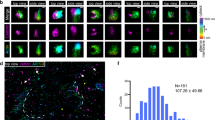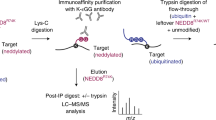Abstract
Intersectin-s is a modular scaffolding protein regulating the formation of clathrin-coated vesicles1,2. In addition to the Eps15 homology (EH) and Src homology 3 (SH3) domains of intersectin-s, the neuronal variant (intersectin-l) also has Dbl homology (DH), pleckstrin homology (PH) and C2 domains1,3,4,5,6,7. We now show that intersectin-l functions through its DH domain as a guanine nucleotide exchange factor (GEF) for Cdc42. In cultured cells, expression of DH-domain-containing constructs cause actin rearrangements specific for Cdc42 activation. Moreover, in vivo studies reveal that stimulation of Cdc42 by intersectin-l accelerates actin assembly via N-WASP and the Arp2/3 complex. N-WASP binds directly to intersectin-l and upregulates its GEF activity, thereby generating GTP-bound Cdc42, a critical activator of N-WASP. These studies reveal a role for intersectin-l in a novel mechanism of N-WASP activation and in regulation of the actin cytoskeleton.
This is a preview of subscription content, access via your institution
Access options
Subscribe to this journal
Receive 12 print issues and online access
$209.00 per year
only $17.42 per issue
Buy this article
- Purchase on SpringerLink
- Instant access to full article PDF
Prices may be subject to local taxes which are calculated during checkout





Similar content being viewed by others
References
Sengar, A. S., Wang, W., Bishay, J., Cohen, S. & Egan, S. E. EMBO J. 18, 1159–1171 (1999).
Simpson, F. et al. Nature Cell Biol. 1, 119–124 (1999).
Guipponi, M., Scott, H. S., Chen, H., Schebesta, A., Rossier, C. & Antonarakis, S. E. Genomics 53, 369–376 (1998).
Roos, J. & Kelly, R. B. J. Biol. Chem. 273, 19108–19119 (1998).
Yamabhai, M. et al. J. Biol. Chem. 273, 31401–31407 (1998).
Okamoto, M., Schoch, S. & Sudhof, T. C. J. Biol. Chem. 274, 18446–18454 (1999).
Hussain, N. K. et al. J. Biol. Chem. 274, 15671–15677 (1999).
Whitehead, I. P., Campbell, S., Rossman, K. L. & Der, C. J. Biochim. Biophys. Acta 1332, 1–23 (1997).
Van Aelst, L. & D'Souza-Schorey, C. Genes Dev. 15, 2295–2322 (1997).
Hall, A. Science 279, 509–514 (1998).
Hart, M. J. et al. J. Biol. Chem. 269, 62–65 (1994).
Nobes, C. D. & Hall, A. Cell 81, 53–62 (1995).
Lamarche, N. et al. Cell 87, 519–529 (1996).
Burbelo, P. D., Drechsel, D. & Hall, A. J. Biol. Chem. 270, 29071–29074 (1995).
Symons, M. et al. Cell 84, 723–734 (1996).
Kozma R., Sarner, S., Ahmed, S. & Lim, L. Mol. Cell Biol. 17, 1201–1211 (1997).
Sarner, S., Kozma, R., Ahmed, S. & Lim, L. Mol. Cell Biol. 20, 158–172 (2000).
Miki, H., Miura, K. & Takenawa, T. EMBO J. 15, 5326–5335 (1996).
Miki, H., Sasaki, T., Takai, Y. & Takenawa, T. Nature 391, 93–96 (1998).
Machesky, L. M. & Insall, R. H. J. Cell Biol. 146, 267–272 (1999).
Glogauer, M., Hartwig, J. & Stossel, T. J. Cell Biol. 150, 785–796 (2000).
Taunton, J. et al. J. Cell Biol. 148, 519–530 (2000).
de Heuvel, E., Bell, A. W., Ramjaun, A. R., Wong, K., Sossin, W. S. & McPherson, P. S. J. Biol. Chem. 272, 8710–8716 (1997).
van Horck, F. P., Ahmadian, M. R., Haeusler, L. C., Moolenaar, W. H. & Kranenburg, O. J. Biol. Chem. 276, 4948–4956 (2001).
Kiyono, M., Satoh, T. & Kaziro, Y. Proc. Natl. Acad. Sci. USA 96, 4826–4831 (1999).
Scita, G. et al. Nature 401, 290–293 (1999).
Qualmann, B., Kessels, M. M. & Kelly, R. B. J. Cell Biol. 150, 111–116 (2000).
De Camilli, P., Slepnev, V. I., Shupliakov, O. & Brodin, L. M. in Synapses (eds Cowan, T. et al.) 217–274 (The Johns Hopkins University Press, 2000).
Gaidarov, I., Santini, F., Warren, R. A. & Keen, J. H. Nature Cell Biol. 1, 1–7 (1999).
Roos, J & Kelly, R. B. Curr. Biol. 9, 1411–1414 (1999).
Merrifield, C. J. et al. Nature Cell Biol. 1, 72–74 (1999).
Duncan, M. C., Cope, M. J. T. V., Goode, B. L., Wendland, B. & Drubin, D. G. Nature Cell Biol. 3, 687–690 (2001).
Pucharcos, C., Estivill, X. & de la Luna, S. FEBS Lett. 478, 43–51 (2000).
Micheva, K. D., Kay, B. K. & McPherson, P. S. J. Biol. Chem. 272, 27239–27245 (1997).
McPherson, P. S. et al. Proc. Natl. Acad. Sci. USA 91, 6486–6490 (1994).
Tong, X.-K. et al. EMBO J. 19, 1263–1271 (2000).
Lamarche-Vane, N. & Hall, A. J. Biol. Chem. 273, 29172–29177 (1998).
Horii, Y., Beeler, J. F., Sakaguchi, K., Tachibana, M. and Miki, T. EMBO J. 13, 4776–4786 (1994).
Hartwig, J. H. J. Cell Biol. 118, 1421–1442 (1992).
Maycox, P. R., Link, E., Reetz, A., Morris, S. A. & Jahn, R. J. Cell Biol. 118, 1379–1388 (1992).
Acknowledgements
We would like to thank H. Miki, and M. Olson for important reagents used in this study. We also thank J. Bergeron and D. A. Schafer for discussion and J. Presley for assistance with confocal microscopy. This research was supported by Canadian Institutes of Health Research (CIHR) grants to P.S.M. and N.L.-V., and by a National Cancer Institute of Canada Grant to N.L.-V. P.S.M. and N.L.-V. acknowledge support from the Canadian Foundation for Innovation. T.P.S. is supported by a USPHS grant and by the Edwin S. Webster Foundation. C.C.Q. is supported by a NINDS grant to S. Hockfield of Yale University. N.K.H. and S.W. are supported by studentships from the Fonds De La Recherche En Santé Du Québec and the Natural Sciences and Engineering Research Council, respectively. S.J. is a CIHR postdoctoral fellow. N.L.-V. is a Junior Scholar of the Fonds De La Recherche En Santé Du Québec. P.S.M. is a CIHR Investigator.
Author information
Authors and Affiliations
Corresponding author
Supplementary information
Supplementary methods and figures
Method S1 Production of cDNA constructs. (PDF 471 kb)
Figure S1 Myc-tagged Cdc42 binds to the DH domain of intersectin-l.
Figure S2 Intersectin-l tail constructs cause a Cdc42 activation phenotype in Swiss 3T3 fibroblasts.
Figure S3 Intersectin-l tail constructs stimulate neurite outgrowth in N1E-115 cells.
Figure S4 Overlay of N-WASP with intersectin SH3 domains.
Figure S5 Co-immunoprecipitation of intersectin-l and N-WASP from co-transfected cells.
Rights and permissions
About this article
Cite this article
Hussain, N., Jenna, S., Glogauer, M. et al. Endocytic protein intersectin-l regulates actin assembly via Cdc42 and N-WASP. Nat Cell Biol 3, 927–932 (2001). https://doi.org/10.1038/ncb1001-927
Received:
Revised:
Accepted:
Published:
Issue Date:
DOI: https://doi.org/10.1038/ncb1001-927
This article is cited by
-
Patterning of the cell cortex by Rho GTPases
Nature Reviews Molecular Cell Biology (2024)
-
CdGAP maintains podocyte function and modulates focal adhesions in a Src kinase-dependent manner
Scientific Reports (2022)
-
Quantitative proteomics revealed modulation of macrophages by MetQ gene of Streptococcus suis serotype 2
AMB Express (2020)
-
Functional screenings reveal different requirements for host microRNAs in Salmonella and Shigella infection
Nature Microbiology (2019)
-
Intersectin-1s deficiency in pulmonary pathogenesis
Respiratory Research (2017)



